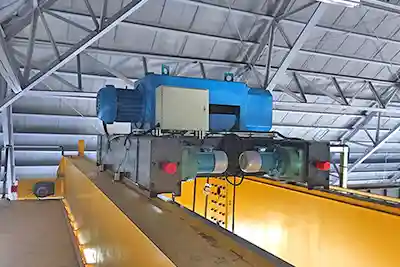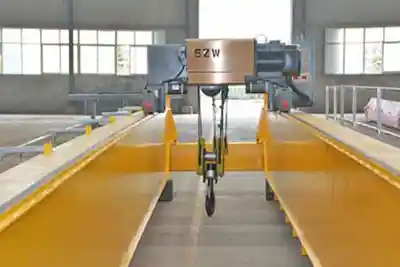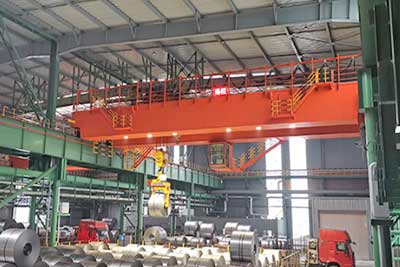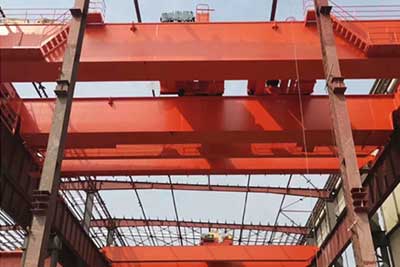How Much Does a 40-Ton Overhead Crane Cost?
A guide on pricing, factors, and key considerations for 40-ton overhead cranes, from basic to high-end models.
Introduction
The cost of a 40-ton overhead crane is essential for anyone considering a purchase. The price can fluctuate due to various factors, such as design complexity, features, and the manufacturer. Whether you’re just beginning to explore crane options or nearing a final decision, knowing what to expect will help you make an informed choice.
- For early-stage buyers: You might have a general idea but need guidance on setting a budget.
- For more advanced buyers: You may be looking for detailed cost breakdowns to finalize your decision.
This section will provide a clear and transparent look at the factors that affect overhead crane pricing, ensuring that no matter where you are in your buying journey, you’ll be able to make the best decision for your needs and budget.
Basics of Overhead Crane Pricing
A 40-ton overhead crane is a heavy-duty lifting machine designed to move large and heavy loads. With a capacity of 40 tons, these cranes are often used in industrial settings where heavy lifting is required. They consist of a horizontal bridge, a trolley for movement, and a hoist to lift and lower objects.
Common Applications for a 40-Ton Crane:
- Manufacturing Plants: Used to move heavy components in production lines, like engines or large machinery parts.
- Construction Sites: Essential for lifting and positioning large building materials or structural components.
- Shipping Ports: Helps with loading and unloading heavy cargo, such as containers and industrial equipment.
- Steel Mills: Used for handling steel billets, sheets, and other heavy metal products.
Significance in Various Industries:
A 40-ton crane plays a crucial role in industries where large, heavy materials are regularly handled. It ensures safety, efficiency, and precision in lifting and moving loads, reducing the need for manual labor and minimizing risk. The crane’s versatility also allows it to be adapted for use in a variety of settings, from automotive manufacturing to construction and shipping, making it an essential piece of equipment in many large-scale operations.
Price Range for 40-Ton Overhead Cranes
Basic Model Prices
Entry-level 40-ton overhead cranes typically come with the essential features required for standard lifting tasks. These cranes usually have a simple design with manual controls and basic safety features, focusing on reliability for general industrial applications.
- Price Range: Basic models usually cost between $50,000 to $100,000. This price depends on factors like the manufacturer, material quality, and regional pricing variations.
Mid-Range Model Prices
Mid-range cranes offer additional features such as advanced controls, better safety mechanisms, and more durable materials. These cranes may come with options like more precise control systems, anti-sway technology, and enhanced load-lifting capabilities for demanding applications.
- Price Range: Expect to pay between $100,000 to $180,000 for a mid-range model. The price will increase with added features like automation, remote control, and more sophisticated safety systems.
High-End Model Prices
High-end 40-ton overhead cranes are highly customized to meet specific needs. These cranes offer advanced features such as remote control operation, specialized lifting mechanisms, and higher-grade materials, often tailored to industries with unique lifting requirements (e.g., hazardous environments, large-scale construction).
- Price Range: High-end models typically cost between $180,000 and $300,000 or more, depending on the level of customization, materials, and special features required.
Each price range reflects the level of complexity and the features included, with basic models offering simple functionality and high-end cranes providing cutting-edge technology and customization. The choice depends on your operational needs and budget.
Key Factors Influencing the Cost of a 40-Ton Overhead Crane
Design and Engineering: Custom vs. Standard Designs
The design of a crane greatly influences its price. Standard designs are cost-effective and can meet general lifting needs. However, custom cranes are often tailored for specific applications and environments, leading to a higher price. Customization may involve unique lifting systems, special dimensions, or specialized features to handle specific loads or work environments.
- Impact on Price: Custom cranes can add anywhere from 20% to 50% to the base cost, depending on the level of customization required.
Material Quality and Durability
The materials used in the construction of the crane also play a significant role in its price. Higher-quality materials, such as high-strength steel or corrosion-resistant coatings, increase the crane's durability and reliability, especially in harsh environments like coastal areas or chemical plants. While these materials come at a higher cost, they ensure that the crane will last longer, reducing the need for frequent repairs and replacements.
- Impact on Price: Choosing high-quality materials can increase the price by 10% to 30% or more, depending on the material specifications and environmental conditions.
Lifting Systems and Mechanisms
The lifting system is the core of any overhead crane, responsible for lifting and moving heavy loads. There are several variations of lifting systems and mechanisms, each offering different features, performance, and cost implications. Below are the key types of lifting systems and their impact on crane pricing:

CD/MD Electric Hoist Trolley Overhead Crane
The CD/MD electric hoist trolley is a standard and widely used lifting mechanism, often found in basic and mid-range overhead cranes. The CD hoist is a single-speed system, while the MD hoist offers dual-speed control, providing better load control and smoother operations. These hoists are known for their reliability and are commonly used for general industrial purposes.
- Price Impact: The CD/MD electric hoist trolley is generally less expensive compared to more advanced systems. The cost is influenced by the size of the hoist and its lifting capacity.
- Applications: Suitable for general lifting tasks in industries such as manufacturing, warehouses, and logistics.

European Style Electric Hoist Trolley Overhead Crane
European style electric hoist trolleys are designed with high-quality standards, often incorporating features like compact design, enhanced efficiency, and improved safety. These hoists are typically used in more demanding industrial environments where precision and durability are key. The European design focuses on easy installation, maintenance, and quiet operation.
- Price Impact: European style hoists are usually more expensive than standard CD/MD hoists due to their advanced design, better performance, and higher-quality materials.
- Applications: Ideal for industries with high-duty cycles, such as automotive manufacturing, heavy-duty material handling, and construction.

Open Winch Hoist Overhead Crane
An open winch hoist trolley features a winch system designed for lifting heavier loads with greater flexibility. This type of system uses a rope and drum mechanism to handle large and heavy loads efficiently. The open design of the winch allows for easy maintenance and access to components.
- Price Impact: Open winch hoists tend to be more expensive than electric hoists due to their ability to handle larger, more complex lifting tasks.
- Applications: Suitable for industries requiring heavy-duty lifting, such as steel mills, shipyards, and heavy construction.

European Style Open Winch Overhead Crane
Similar to the European style electric hoist trolley, the European style open winch trolley combines high-quality standards and efficient design with the added capability of lifting heavier loads using an open winch system. These systems are ideal for lifting in extreme conditions or for applications that require precise load control.
- Price Impact: European style open winch hoists are among the highest in price due to their advanced engineering, design features, and ability to handle very heavy or complex loads.
- Applications: Perfect for industries like aerospace, large-scale construction, and specialized heavy lifting operations.
Impact on Crane Price
The type of lifting system used in a 40-ton overhead crane plays a significant role in the overall cost. Basic systems like the CD/MD electric hoist trolley offer a more budget-friendly option, while more advanced systems, such as European style electric hoist trolleys or open winch hoists, add to the cost due to their increased capabilities, performance, and specialized features.
- Basic systems are cost-effective for general lifting tasks but may lack the advanced features required for specific applications.
- Advanced systems offer enhanced performance, precision, and safety but come at a higher price due to their complexity and the technology involved.
When considering a crane purchase, it's essential to assess the specific lifting needs of your operation, as this will directly influence the choice of lifting mechanism and, ultimately, the overall crane cost.
Safety and Technology Features
Modern overhead cranes are equipped with advanced safety and control technologies. Features like overload protection, anti-sway systems, and remote control operation significantly enhance the crane's performance, safety, and ease of use. These features not only protect workers and equipment but also improve operational efficiency.
- Impact on Price: The addition of these safety and technology features can increase the price by 15% to 40% depending on the complexity and integration level.
Manufacturer and Location
The reputation of the manufacturer and the location where the crane is built can also affect its price. Well-known manufacturers with a reputation for quality and innovation may charge a premium. Additionally, cranes manufactured in countries with higher labor costs or stricter regulations, like the US or Europe, may cost more than those produced in regions with lower production costs, such as Asia.
- Impact on Price: Manufacturer reputation can add 5% to 20% to the cost, while location-based cost differences can fluctuate based on regional factors.
Installation and Maintenance
The installation of a 40-ton overhead crane involves labor, equipment setup, and possibly structural adjustments to accommodate the crane. Additionally, the cost of long-term maintenance, which ensures the crane continues to operate efficiently, should be considered. Some manufacturers offer service contracts that cover routine inspections, repairs, and parts replacement, which can provide peace of mind and save money in the long run.
- Impact on Price: Installation costs can range from $10,000 to $50,000 depending on the complexity of the installation. Maintenance contracts can add an ongoing cost of $2,000 to $10,000 per year.
Each of these factors can significantly influence the overall cost of a 40-ton overhead crane. By understanding their impact, buyers can make more informed decisions about the features they need versus their budget.
Additional Costs to Consider Beyond the Crane
Shipping and Handling Fees
Shipping large, heavy equipment like a 40-ton overhead crane comes with significant costs. The weight and size of the crane require special transportation methods. Key factors influencing shipping fees include:
- Distance: Longer distances result in higher shipping costs.
- Transport Type: Flatbed trucks or cranes for unloading may be necessary, depending on the site.
- Special Permits: These might be required for heavy loads crossing state or national borders.
Shipping costs can range from a few thousand dollars to tens of thousands depending on these variables, so it's essential to budget for this when planning your purchase.
Customization and Add-Ons
If you require custom features for your crane, such as a specialized hoist, unique control systems, or specific lifting configurations, these can significantly increase the cost. Customization requires extra engineering, materials, and manufacturing time, all of which add to the price. Make sure to consider:
- Specialized configurations based on your operational needs.
- Bespoke controls or upgraded systems for enhanced performance.
These additional features can elevate the base price, so it’s important to account for them in your budget.
Training and Support
After purchasing your crane, you’ll need to ensure that your team can operate and maintain it effectively. This comes with its own costs:
- Operator Training: Programs to teach safe operation and handling of the crane.
- Maintenance Training: Ensuring your team can maintain the crane’s efficiency and longevity.
- Ongoing Support: Some manufacturers offer ongoing technical support or service contracts for continued assistance.
Training costs vary, but you can expect to spend from a few hundred to a few thousand dollars. These costs are essential to ensure the safety and reliability of your crane over time.
By factoring in these additional expenses—shipping, customization, and training—you can better prepare for the total investment in your 40-ton overhead crane, ensuring it meets your needs and operates efficiently from day one.
Cost Transparency in the Crane Industry
Importance of Obtaining Detailed Quotations
When purchasing a 40-ton overhead crane, obtaining a detailed quotation is essential for understanding the true cost of the crane. A comprehensive quotation allows you to compare prices across different suppliers and ensures you’re aware of all costs involved before making a decision. Without transparency in pricing, you may end up with unexpected costs during installation or after the crane is in operation, potentially affecting your budget.
Key Items to Look for in a Quotation
To ensure a clear cost breakdown, pay attention to the following key items in a crane quotation:
- Materials and Components: The cost of raw materials (e.g., steel, corrosion-resistant coatings) and key components (e.g., motors, control systems) used in the crane’s construction.
- Labor Costs: Charges for design, engineering, manufacturing, and installation services. This should include both skilled labor and any specialized work required for customization.
- Shipping and Handling: Costs for transporting the crane to your site, including potential permits for large loads and any special handling requirements.
- Customization or Add-Ons: If your crane includes specialized features (e.g., custom hoists, control systems), these should be clearly listed as separate line items.
- Training and Support: Costs for operator and maintenance training programs, as well as any ongoing technical support or maintenance services.
A detailed quotation gives you a clear picture of where your money is going and helps avoid hidden fees later.
Tips for Negotiating Pricing with Suppliers and Manufacturers
Negotiating with suppliers and manufacturers can help reduce overall costs. Here are some tips to get the best deal:
- Request Multiple Quotes: Don’t settle for the first price you receive. Request quotes from multiple suppliers to compare pricing and service offerings.
- Be Clear About Your Needs: Clearly define your crane requirements and any special features. The more precise you are, the less likely you are to incur unnecessary add-ons or changes during production.
- Ask for a Price Breakdown: Ensure the quotation provides a detailed breakdown of all costs. This will allow you to identify any potential areas for negotiation.
- Negotiate Bulk Discounts: If you’re purchasing multiple cranes or require additional services (e.g., extended maintenance contracts), ask for a discount on larger orders or bundled services.
- Consider After-Sale Services: Some suppliers may offer discounts on future maintenance or spare parts if you commit to a long-term service agreement.
By paying close attention to your quotation and negotiating effectively, you can ensure cost transparency and make a more informed decision about your crane investment.
Conclusion
Factors Influencing the Cost of a 40-Ton Overhead Crane
The price of a 40-ton overhead crane depends on several factors, including:
- Design and engineering (custom versus standard)
- Material quality and durability (such as corrosion-resistant coatings)
- Lifting mechanisms (single or double girder designs)
- Safety and technology features (e.g., overload protection, anti-sway systems)
- Manufacturer and location (regional pricing and reputation)
- Installation and maintenance (including long-term service contracts)
These factors combine to determine the final cost, making it essential to understand each component when considering your investment.
Emphasis on the Importance of Balancing Cost and Quality for Long-Term Value
While the initial price of a crane may seem like the most important factor, it’s crucial to consider long-term value. Opting for cheaper options might save money upfront but could result in higher maintenance costs, downtime, or reduced safety. On the other hand, investing in higher-quality materials and advanced features can enhance the crane’s durability, efficiency, and lifespan, ultimately delivering greater value over time. Always aim for a balance between cost and quality to maximize your return on investment.
Advice for Buyers at Different Stages of Their Purchasing Journey
For buyers just starting their research:
- Focus on understanding the basic features and costs.
- Collect multiple quotes to compare pricing and services.
For buyers ready to purchase:
- Ensure you have a detailed, transparent quotation.
- Take the time to negotiate pricing and inquire about long-term support.
For buyers with specific needs:
- Don’t hesitate to request customized solutions and a breakdown of additional costs for any special features.
- Consider the full cost of ownership, including shipping, training, and ongoing maintenance.
By following this approach, you’ll be better equipped to make a well-informed decision that meets both your budget and operational needs.




